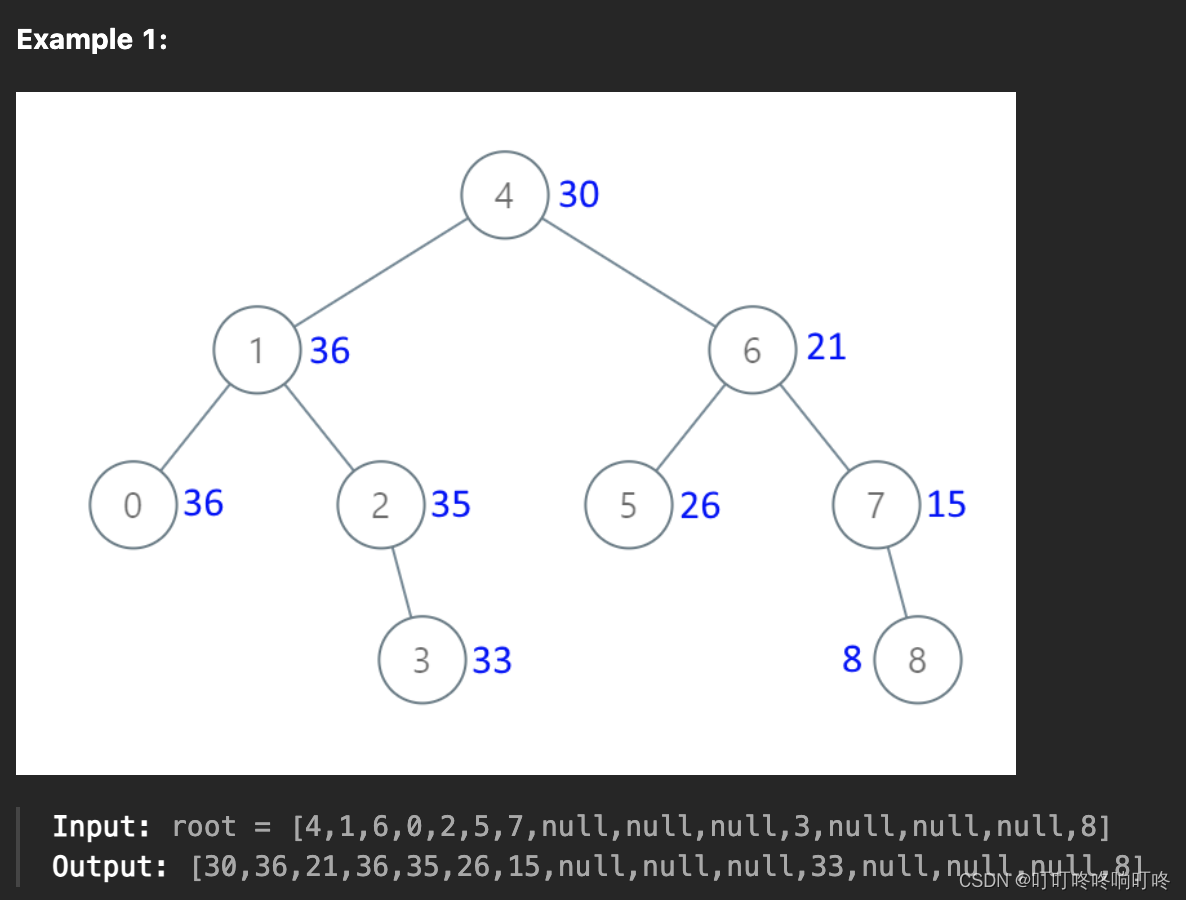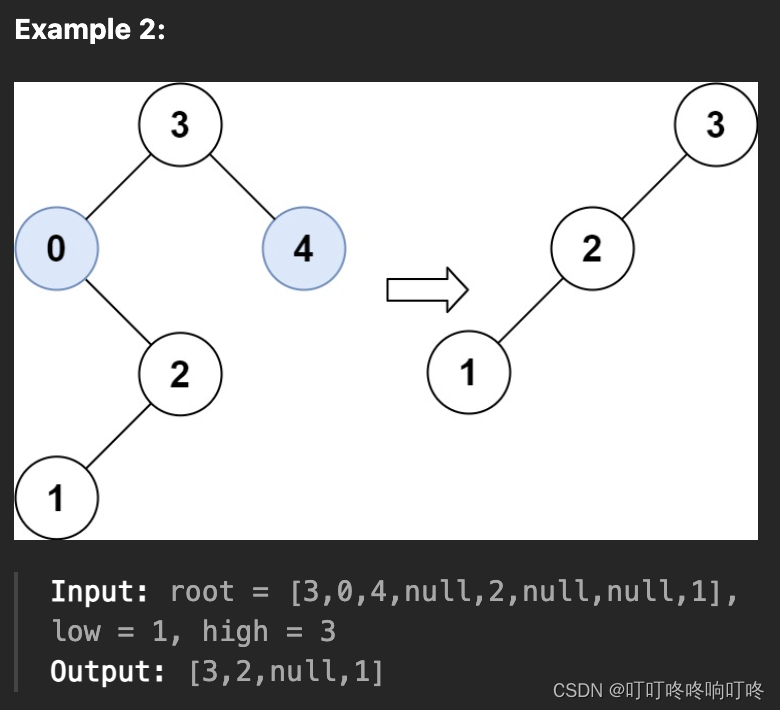108. Convert Sorted Array to Binary Search Tree
Given an integer array nums where the elements are sorted in ascending order, convert it to a
height-balanced
binary search tree.
思路:
一个高度平衡二叉树是指一个二叉树每个节点 的左右两个子树的高度差的绝对值不超过 1。因为是有序数组,所以取Node的位置并不难,类似于二分法。用递归感觉比迭代更简单一点?
递归法:
class Solution(object):
def traversal(self, nums, left, right):
if left <= right:
mid = (left + right)//2
else:
return None
root = TreeNode(nums[mid]) # 这里采用中序遍历。想清楚递归的input和output。一开始root为Tree的根节点,逐层递归到叶节点,这时候return为None,那么叶节点是这里的root,root.left = None。再回到上一层,root为刚才叶节点的parent,root.left就是叶节点了。最后递归完毕回到root。
root.left = self.traversal(nums, left, mid-1)
root.right = self.traversal(nums, mid+1, right)
return root
def sortedArrayToBST(self, nums):
"""
:type nums: List[int]
:rtype: TreeNode
"""
root = self.traversal(nums, 0, len(nums)-1)
return root
迭代法:
from collections import deque
class Solution:
def sortedArrayToBST(self, nums: List[int]) -> TreeNode:
if len(nums) == 0:
return None
root = TreeNode(0) # 初始根节点
nodeQue = deque() # 放遍历的节点
leftQue = deque() # 保存左区间下标
rightQue = deque() # 保存右区间下标
nodeQue.append(root) # 根节点入队列
leftQue.append(0) # 0为左区间下标初始位置
rightQue.append(len(nums) - 1) # len(nums) - 1为右区间下标初始位置
while nodeQue:
curNode = nodeQue.popleft()
left = leftQue.popleft()
right = rightQue.popleft()
mid = left + (right - left) // 2
curNode.val = nums[mid] # 将mid对应的元素给中间节点
if left <= mid - 1: # 处理左区间
curNode.left = TreeNode(0)
nodeQue.append(curNode.left)
leftQue.append(left)
rightQue.append(mid - 1)
if right >= mid + 1: # 处理右区间
curNode.right = TreeNode(0)
nodeQue.append(curNode.right)
leftQue.append(mid + 1)
rightQue.append(right)
return root
538. Convert BST to Greater Tree
Given the root of a Binary Search Tree (BST), convert it to a Greater Tree such that every key of the original BST is changed to the original key plus the sum of all keys greater than the original key in BST.
As a reminder, a binary search tree is a tree that satisfies these constraints:
- The left subtree of a node contains only nodes with keys less than the node's key.
- The right subtree of a node contains only nodes with keys greater than the node's key.
- Both the left and right subtrees must also be binary search trees.

思路:二叉搜索树上每个节点按序累加之前的节点值之和,成为更大的节点值。
注意二叉树是有序的,根据例子,是进行了右中左的顺序累加的。所以也就是以右中左的顺序遍历二叉树就好。感觉把二叉树的搜索顺序搞清楚后,解题代码就比较模版化了。回头可以再好好复习一下二叉树的搜索。
递归法:
class Solution(object):
def __init__(self):
self.last = 0
def traversal(self, root):
if root is None:
return
self.traversal(root.right) # left
root.val = root.val + self.last # middle
self.last = root.val
self.traversal(root.left) # right
def convertBST(self, root):
"""
:type root: TreeNode
:rtype: TreeNode
"""
self.last = 0
self.traversal(root)
return root 化简一些的递归法:
class Solution:
def __init__(self):
self.count = 0
def convertBST(self, root: Optional[TreeNode]) -> Optional[TreeNode]:
if root == None:
return
'''
倒序累加替换:
'''
# 右
self.convertBST(root.right)
# 中
# 中节点:用当前root的值加上pre的值
self.count += root.val
root.val = self.count
# 左
self.convertBST(root.left)
return root 迭代法:
class Solution:
def __init__(self):
self.pre = 0 # 记录前一个节点的数值
def traversal(self, root):
stack = []
cur = root
while cur or stack:
if cur:
stack.append(cur)
cur = cur.right # 右
else:
cur = stack.pop() # 中
cur.val += self.pre
self.pre = cur.val
cur = cur.left # 左
def convertBST(self, root):
self.pre = 0
self.traversal(root)
return root669. Trim a Binary Search Tree
Given the root of a binary search tree and the lowest and highest boundaries as low and high, trim the tree so that all its elements lies in [low, high]. Trimming the tree should not change the relative structure of the elements that will remain in the tree (i.e., any node's descendant should remain a descendant). It can be proven that there is a unique answer.
Return the root of the trimmed binary search tree. Note that the root may change depending on the given bounds.

思路:删除掉搜索二叉树BST中值不满足[left, right]的节点。这题难的点就是例子中不满足要求的左节点 的右节点又满足要求了。
class Solution:
def trimBST(self, root: TreeNode, low: int, high: int) -> TreeNode:
#Iteration:
if not root:
return None
while root and (root.val < low or root.val > high):
# Find the root falling in the range [L, R]
if root.val < low:
root = root.right # too small, go right
else:
root = root.left # too large, go left
cur = root
# Remove the root out of the range [L, R]
# Left
# Root is already within [L, R], deal with the case that the left children is smaller than left
while cur: # 第一重循环是遍历所有的左子树,去除落在【L,R】之外的左子树(其实因为有序,判断<L即可)
while cur.left and cur.left.val < low: # 第二重while循环的目的是看根节点(cur.left)是不是超过了范围,如果超过,就不断向根节点的右子树找,直到又回到范围内或者到达叶节点。一旦找到了范围内的节点或者到达叶节点,跳出循环,继续在第一重循环里往左找不满足范围要求的左叶子树。
# 一旦当前的cur.left不满足。cur.left就被替换为右子树来继续找了,也就实现了删除当前不满足要求的cur.left的目的
cur.left = cur.left.right # left children must be smaller, so we move to the right children
cur = cur.left # keep checking the left children.
cur = root # 回归出发点root,开始向右边界找
# Right
while cur:
while cur.right and cur.right.val > high:
cur.right = cur.right.left
cur = cur.right
return root
class Solution:
def trimBST(self, root: TreeNode, low: int, high: int) -> TreeNode:
if root is None:
return None
if root.val < low:
# 寻找符合区间 [low, high] 的节点
return self.trimBST(root.right, low, high)
if root.val > high:
# 寻找符合区间 [low, high] 的节点
return self.trimBST(root.left, low, high)
root.left = self.trimBST(root.left, low, high) # root.left 接入符合条件的左孩子
root.right = self.trimBST(root.right, low, high) # root.right 接入符合条件的右孩子
return root一点碎碎念:写博客的初衷就是记录自己的练习的过程。我还处在刷题的初期->中期的阶段吧。我目前刷题的习惯是每次看一下题,有思路就直接写,没有思路就先去看一些解析。看了解析如果觉得比较清楚了就自己写出来,不然继续看答案,看了答案后盖住答案再自己写。如果看了答案还不太明白或者太绕,一次性自己肯定写不下来的话,我就会一边把答案抄一边写注释分析。这样是为了防止自己花太多时间困在一道题上(最近还真挺忙的,抽出时间来刷题),也防止畏难了就分心了。所以这个博客里的大部分答案是源于其他博客的,主要是卡哥的代码随想录(link见reference),我只是答案的搬运工,不过我附上了主要是自己写的思路。
写这个博客的目的是记录思路方便自己回看复习,也是站在一个刷题入门者的角度阐述一下自己的思路吧,如果能鼓励到其他刷题的同路人或者带来一点点的启发也算是额外之喜了。
Reference:























 1144
1144

 被折叠的 条评论
为什么被折叠?
被折叠的 条评论
为什么被折叠?








